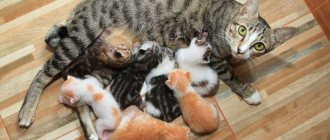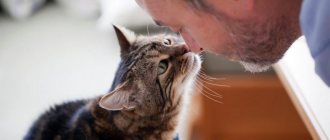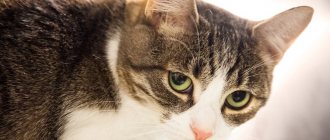On average, pregnancy in cats lasts 65 days (plus or minus 5 days). This period usually guarantees the birth of healthy kittens. But how to know that a cat is giving birth - not every person knows the signs of this event. Many inexperienced owners begin to worry about the upcoming event as soon as they notice that their pet is pregnant. The owner of a cat who is about to give birth for the first time experiences special experiences. And the pet itself often shows anxiety. And I must say: not in vain.
But don't worry too much. You will have enough time to become familiar with the cat's behavior during this period and prepare the necessary supplies for giving birth at home. First, let's try to understand what signs can be used to guess that a cat is pregnant. It will be easiest to recognize an “interesting position” and calculate the date of fertilization if the mating was planned, and you know from what point to keep a record of the pregnancy, which is conventionally divided into three stages with characteristics characteristic of each.
Stages of gestation of kittens
A cat can become pregnant for the first time at the age of six months, when the first heat usually appears. But most veterinarians believe that only a strong female who is at least 12 months old can bear healthy kittens. Pregnancy occurs in 3 stages:
After mating, the cat's genital swelling is visible, but this does not mean that she is fertilized. The first signs will clearly appear from the 3rd week:
- the pet becomes lethargic, eats poorly, moves little, sleeps more;
- within 2-3 days she vomits repeatedly;
- nipples enlarge and acquire a bright pink color or, conversely, become lighter;
- When palpating the cat's genitals, the veterinarian notices an enlarged uterus.
During the middle period of pregnancy, the animal noticeably gains weight as the fetus actively develops. By the 6th week, the amount of amniotic fluid increases and the kittens begin to move for the first time. By stroking your pet's belly, you can carefully “feel” the future children.
At 7-9 weeks, the cat’s excitement intensifies, she fussily rushes around the apartment in search of a future “nest”. Kittens move actively, which is especially noticeable in a sleeping cat. The animal restlessly licks its genitals.
How is the pregnancy period going?
The owner of the cat can calculate in advance the approximate date of labor. Pregnancy in animals lasts about 60-65 days. Full-term kittens are born healthy.
If a cat exhibits pathological signs during pregnancy, there is a chance that labor will begin ahead of schedule. To ensure that your pet bears a healthy litter and her pregnancy does not end tragically, be sure to show the cat to the veterinarian throughout the entire pregnancy. This is especially true if pregnancy occurs with complications.
Preparing for childbirth
Often pets give birth so quietly and carefully that the owner does not even have time to notice any traces of the event. But in case of complications, the pet may need human help, so it is better to find out in advance how to determine that a cat is giving birth and carefully prepare for this event.
By the end of the third trimester of pregnancy, a caring owner should stock up on items and medications that may be useful during childbirth, as well as immediately after it. So, if you are worried about the health of your pet and her future children, you should definitely have on hand at the time of lambing:
- Oxytocin is a drug that stimulates labor in case it is delayed.
- Sterile latex gloves.
- Sterile scissors and thread.
- Antiseptic agents in powder and liquid form intended for animals.
- Zelenka and cotton balls for treating the umbilical cord.
- A special suction, bulb or pipettes to remove fluid from the kitten’s respiratory tract if it begins to choke.
- Clean terry towels for drying kittens.
- Phone veterinarian for urgent consultation.
- Cat milk replacer (she may not get it).
- A durable cardboard box for kittens with low sides (it doesn’t matter whether you buy it at a pet store or make it yourself - the main thing is that the cat can freely “travel” from and to it without disturbing the kittens).
Embryo development by trimester
So, we have decided on the number of days. Maximum – 72 days, or 9 weeks. These weeks, in turn, are divided into 3 trimesters, each of which accounts for 3 weeks, respectively.
First trimester
Considering that in one pregnancy a cat usually gives birth to from 1 to 6 kittens, it is not difficult to guess that during a meeting, fertilization of not one, but several eggs occurs at once. Fertilized eggs, future kittens, attach to the walls of the uterus the next day. Moreover, depending on the sex of the future baby, zygotes occupy predetermined places in the branches of the uterus. The place where the fetus clings is called the chorion. The placenta forms around it.
In the first week after conception, the size of the fetus can be compared to a speck of dust, but by day 15 the size of the embryo is already 10 mm. By day 18, you can see the tiny paws of the future kitten. Closer to three weeks, internal organs actively begin to develop inside the fetus.
Second trimester
The second trimester is the time for kittens to grow bone and muscle mass. At the same time, the brain begins to grow, the hormonal system in the small body begins to develop, and the formation of the genital organs begins. It is during this period that the fetus takes on the usual feline shape, and the formation of the muzzle is completed. The kitten grows small soft claws.
Third trimester
The size of one kitten by the beginning of the third trimester reaches about 8 cm. Just before birth, the baby usually grows another 5 cm. As for internal development, it is coming to an end, the external characteristics of the animal become more obvious: the tail grows, the skin thickens body, ears grow. At the same time, wool appears, and a little later it acquires the required color.
Signs of approaching labor
So, you have already purchased and prepared everything you need, all you have to do is wait for the birth to begin. And here the question arises again: how to understand that a cat is giving birth; signs of the end of pregnancy seem to be obvious, but an inexperienced owner needs additional information in order to have time to come to the pet’s aid at the crucial moment.
Signs that a cat is about to give birth are:
- the animal shows strong anxiety, meows loudly, looks for a comfortable, often hidden place to relieve itself of the burden;
- the mammary glands greatly increase in size, the skin around the nipples dries and peels;
- 24 hours before lambing, the pet experiences lactation;
- body temperature drops to 37 degrees and below;
- on the day of lambing, the pet completely loses interest in food;
- a few hours before lambing, the cat begins to bend its back frequently;
- the animal licks the genitals, from which a malicious odor often emanates (sometimes you can notice the release of the birth plug, which is a mucous clot - transparent or having a pinkish, yellowish and even greenish tint, but usually the animal “tips up” the plug, which comes out in parts, along with the secretions ).
The removal of the plug and an actively “moving” belly indicate that the pet is about to begin or has already begun contractions.
Her behavior may change
As your cat enters the last few weeks of pregnancy, she may show several temporary changes in behavior. These may vary from cat to cat. Some cats will become much more solitary and will spend time hiding in a quiet place. Others will become much more affectionate and will always seek the attention of their owners. Some cats will be restless and unable to calm down.
Keep an eye on these changes and do your best to meet your cat's needs!
How can a person help a giving birth cat?
If a cat, on the eve of lambing, has burrowed away from you in a far, secret corner, there is no need to disturb her. Just be prepared to quickly come to the rescue if trouble arises. But when your pet is nervous and doesn’t leave your side, she definitely wants help immediately.
In this case, you should definitely calm her down and caress her. Don't let your cat squat: this could harm her babies. Try to lay her down on her side by cuddling her and encouraging her with warm words. In addition, you can stimulate labor yourself by stroking your tummy and spine. When your pet pushes, allow her to rest her hind legs on your hand. Always keep clean, warm water on hand: an exhausted woman in labor will often experience increased thirst.
The birth process
Kittens ready to be born line up to be born in the animal’s two-horned uterus. The birth process is divided into 3 stages:
- The cat feels contractions of the uterus and at the same time the urge to have a bowel movement. The cervix begins to open slightly. Often at this stage the birth plug comes out along with mucous secretions.
- In the second phase, contractions become more intense and painful, the cervix opens completely, preparing to let the kittens move through the birth canal. The cat strains, trying with all her might to “push through” the cubs. This is how a healthy kitten is born with a favorable course of labor. If the amniotic sac has not burst earlier, the baby is born in it. Usually the woman in labor frees the kitten herself by gnawing the shell. But it happens that she leaves the place of birth in fright or gets lost during the first lambing, and then you must come to the rescue by cutting the bladder with sterile scissors so that the baby does not suffocate. The next cub should emerge 15, maximum 40 minutes after the first.
- At the final stage of labor, the placenta is separated from the mother. The cat must eat one of the nursery places - this will help her quickly realize that she is a mother and speed up lactation. Make sure that after each kitten there is an afterbirth. The placenta remaining in the pet’s body can rot, which will lead to severe inflammation and even death of the animal. At the same time, the cat may eat a stillborn or too weak kitten, which is best avoided.
Well, the birth is over. Make sure your pet has given birth to all the kittens by feeling her belly: it should be soft and empty. If you still have doubts, and the cat is in no hurry to feed and caress the cubs, but still shows signs of anxiety, seek advice from a specialist.
You can also contact our site's staff veterinarian, who will respond to them as soon as possible in the comment box below.
Important Tips
- In a domestic cat, pregnancy and childbirth should take place in the house, since there is a high probability of contracting an infection outside;
- During pregnancy, a cat should be kept separate from other animals: firstly, the pet can become aggressive, get into a fight and injure itself, and secondly, if several cats live in the house, there is a high probability of a double pregnancy, in which case the offspring may not survive;
- During pregnancy, anthelmintic, anti-flea and other medications should not be given - prevention should be carried out in advance, and medications should be reserved for emergency cases;
- The pet's nutrition must be balanced and correct; we will discuss this issue in more detail later;
- Monitor your pet carefully; during pregnancy, cats become clumsy, so do not let her climb heights - a fall can cause serious injury and termination of pregnancy;
- Before giving birth, you need to prepare a comfortable nest - this can be a box with newspapers or rags, but you should not use napkins or thin paper - it can stick to the kitten, and the cat will refuse to feed and lick it. The place for the box should be quiet, warm, secluded, without drafts;
- Just in case, find out the phone number of the nearest veterinarian if the birth is protracted or difficult;
- If you notice such dangerous symptoms as a weakened cat, fever, refusal to eat, or increased vaginal discharge, contact your veterinarian.











